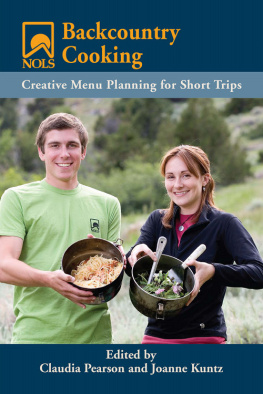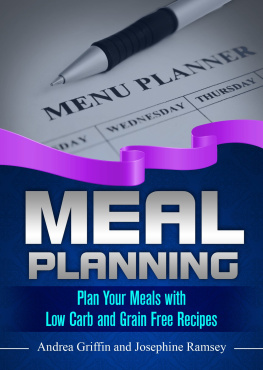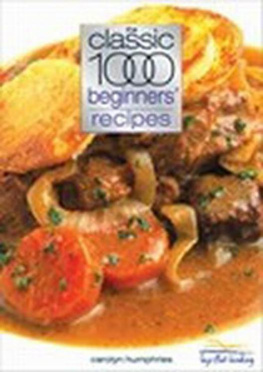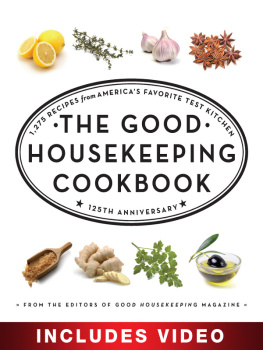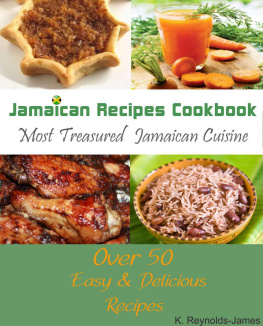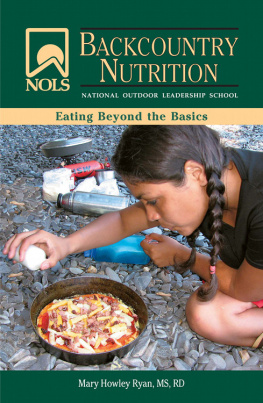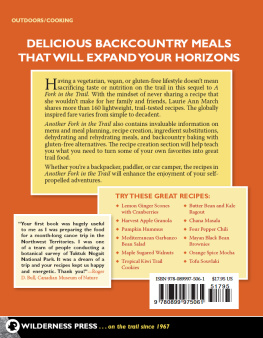
NOLS
Backcountry
Cooking

NOLS
Backcountry
Cooking
Creative Menu Planning
for Short Trips
Edited by Claudia Pearson
and Joanne Kuntz
STACKPOLE
BOOKS
Copyright 2008 National Outdoor Leadership School
Published by
STACKPOLE BOOKS
5067 Ritter Road
Mechanicsburg, PA 17055
www.stackpolebooks.com
All rights reserved, including the right to reproduce this book or portions thereof in any form or by any means, electronic or mechanical, including photocopying, recording, or by any information storage and retrieval system, without permission in writing from the publisher. All inquiries should be addressed to Stackpole Books, 5067 Ritter Road, Mechanicsburg, Pennsylvania 17055.
Printed in the United States of America
First edition
10 9 8 7 6 5 4 3 2
Cover design by Caroline Stover
Cover photograph by Brad Christensen
ISBN: 978-0-8117-4116-3 (ePub)
The print edition of this title was manufactured to FSC standards using paper from responsible sources
Library of Congress Cataloging-in-Publication Data
NOLS backcountry cooking : creative menu planning for short trips / edited by Claudia Pearson and Joanne Kuntz ; Illustrations by Mike Clelland. 1st ed.
p. cm.
Includes index.
ISBN-13: 978-0-8117-3464-6
ISBN-10: 0-8117-3464-1
1. Outdoor cookery. 2. Menus. I. Pearson, Claudia, 1955 II. Kuntz, Joanne. III. National Outdoor Leadership School (U.S.)
TX823.N63 2008
641.578dc22
2007023698

QED stands for Quality, Excellence and Design. The QED seal of approval shown here verifies that this eBook has passed a rigorous quality assurance process and will render well in most eBook reading platforms.
All eBook files created by eBook Architects are independently tested and certified with the QED seal. For more information please see:
ebookarchitects.com/QED.php
About NOLS
With the goal of training leaders to serve the growing number of people using the wilderness, Paul Petzoldt and Tap Tapley led the first NOLS expedition, an educational journey into wild land that started on June 8, 1965. Spanning over four decades, NOLS graduates now number more than 80,000 from around the world. The mission of NOLS (and Pauls original dream) abides still in an educational organization rooted in extended wilderness expeditions. Students travel away from civilization into mountains, deserts, and oceans, into heat and cold, to learn the skills they need to run their own expeditions and to lead others.
Lessons in team building, self-confidence, problem solving, sound judgment, and overall competence (including, yes, cooking) are a part of all NOLS courses. The leadership qualities gained last long after the course ends and are readily adaptable to life this side of the trailhead.
NOLS promotes protection of its wilderness classrooms through environmental education and stewardship, reaching out to larger audiences by way of research, seminars, short specialized courses, and publications.
In a world that humans like to think they dominate, the lessons learned from direct experience with nature are, as they have always been, of the utmost importance. If anything, those lessons are even more important today. The staff at NOLS seeks to be open to those lessons as individuals, to apply them to life and to the management of the school, and to make them available to the world community.
Wilderness, education, leadership, safety, community, and excellencethese values define and direct NOLS. For more information call (800) 710-NOLS or visit us at www.nols.edu.
Introduction
You might be one of the many thousands who have digested NOLS Cookery, a detailed presentation of the National Outdoor Leadership Schools (NOLS) bulk rationing system that has fed more people over the past forty plus years than some small nations. The bulk rationing system, in case you sit unaware, provides every cook group (usually two to four participants) with a wide selection of bulk foods and spices. Each group decides what to cook at each meal with the help of NOLS Cookery and knowledgeable peers or instructors. There are no set menus, and you learn, on a NOLS course, the art of cooking in the field. The system works wonderfully well for large groups on multiweek expeditions, but smaller groups going out for shorter lengths of timefive days or lessmight want to consider menu planning instead. With the menu planning system, all meals are determined in advance, and the food purchased and packed accordingly. And so you hold in your hand NOLS Backcountry Cooking: Creative Menu Planning for Short Trips, written to answer this question: How do I plan food for a short trip with a few friends and still maintain the NOLS culinary experience?
You could supply the food for a wilderness trip by stopping by your favorite outdoor specialty shop, or even one of the many massive buy-it-all-here stores, and stocking up on freeze-dried fare. You will not suffer nutritionally after two to five days of rehydrated pasta primavera, but prepackaged freeze-dried food jacks up the expense of a trip quite a ways beyond the menu planning system. More importantly to us, you will miss an opportunity to experience not only real and creative cooking in the field but also the delights of the camp kitchen without undue stress on your time management plan.
Why is that important to us? At NOLS we embrace the total outdoor living experience. Eating is far more than wolfing down a pot of energy for the upcoming miles of trail or river. Cooking is an essential outdoor skill, like traveling safely on durable surfaces and setting up a comfortable and environmentally-friendly camp. Cooking becomes a social event, and the camp kitchen, approached thoughtfully and creatively, is anticipated, relished, and bound to generate many lasting and happy memories. Yes, the menu planning system consumes more time than eat-and-run meal plans. But we believe, with all our hearts and stomachs, it is time very well spent.
Plan to
SUCCEED
Food is fuel, yes, but food can and should also be fun. Who wants to end an invigorating day of hiking or paddling with a bowl of tasteless noodles or bland rehydrated beans? Only the unenlightened or the uneducated. Read onand be neither.
Menu
PLANNING
T he menu planning system does not involve rocket science. It does involve simplicity and convenience without a heavy burden on your bank account. Most of the thinking happens before you ever leave home, and that means you arrive at your campsite able to prepare a tasty and nourishing meal without spending unnecessary time and energy on food prep in the field. Menu planning is ideal for short trips, and we have focused on two- to five-day trips. We will run through the steps here via a sample menu plan for a three-day, two-night trip for three people.
THE STEPS OF THE MENU PLANNING SYSTEM
Step 1
Determine the number of meals you will need for the duration of your tripthe number of breakfasts, lunches, and dinners. All you need, so far, is to know when you are leaving and when you are returning home. For our purposes, lets say you want to leave work early on Friday for a two-hour drive to the trailhead and return Sunday evening. You will need two dinners (Friday and Saturday), two breakfasts (Saturday and Sunday), and two lunches (Saturday and Sunday).
Next page
